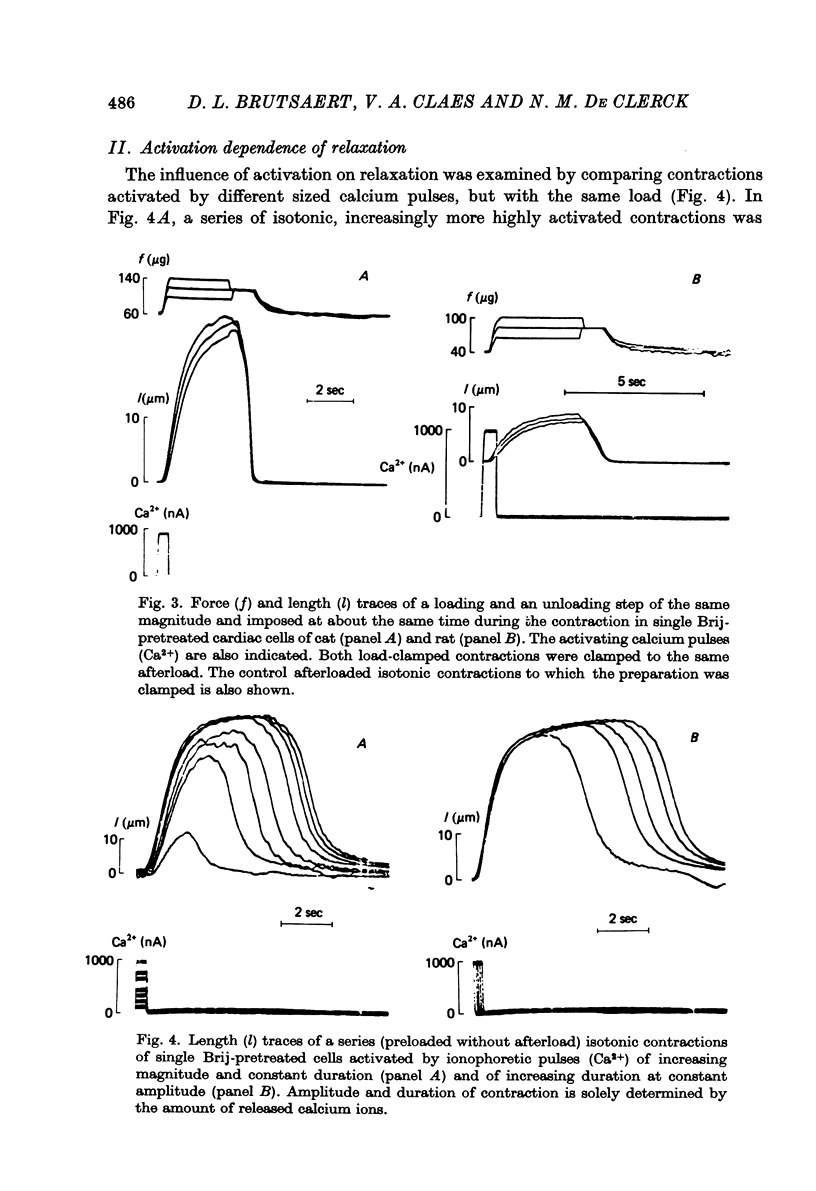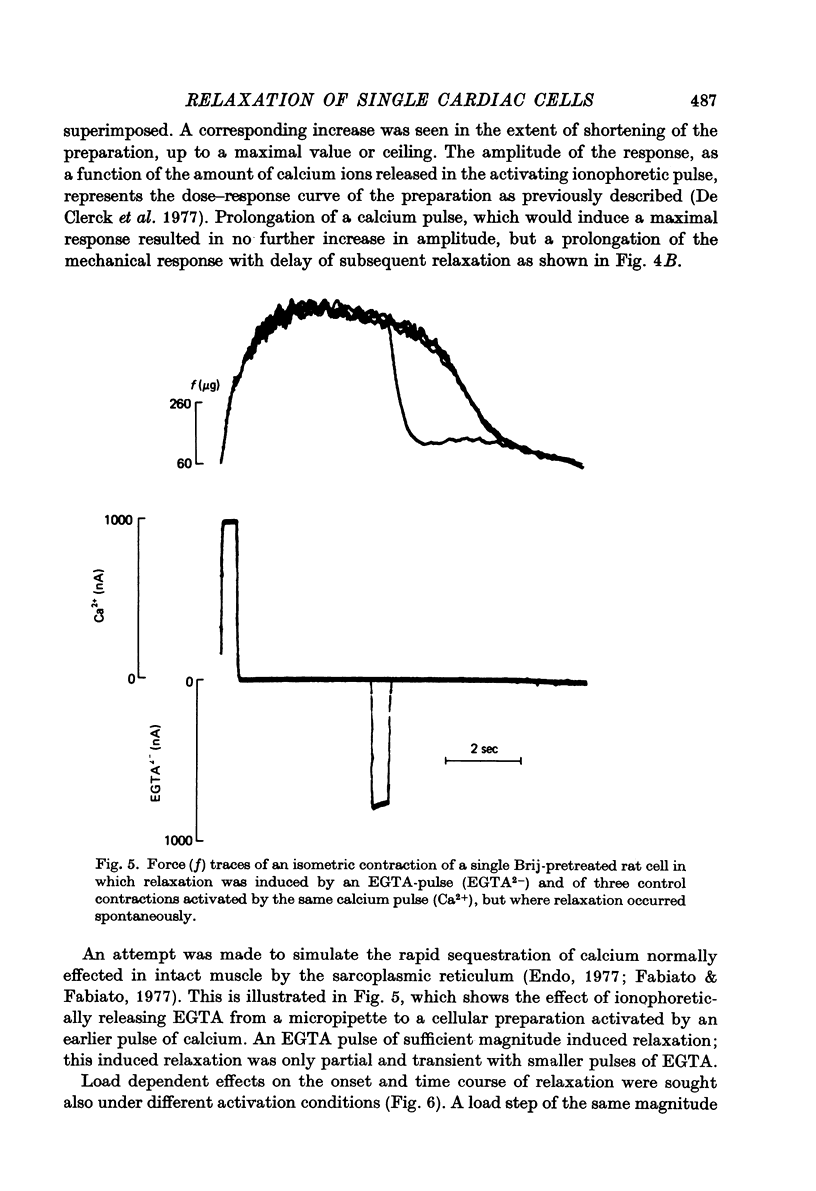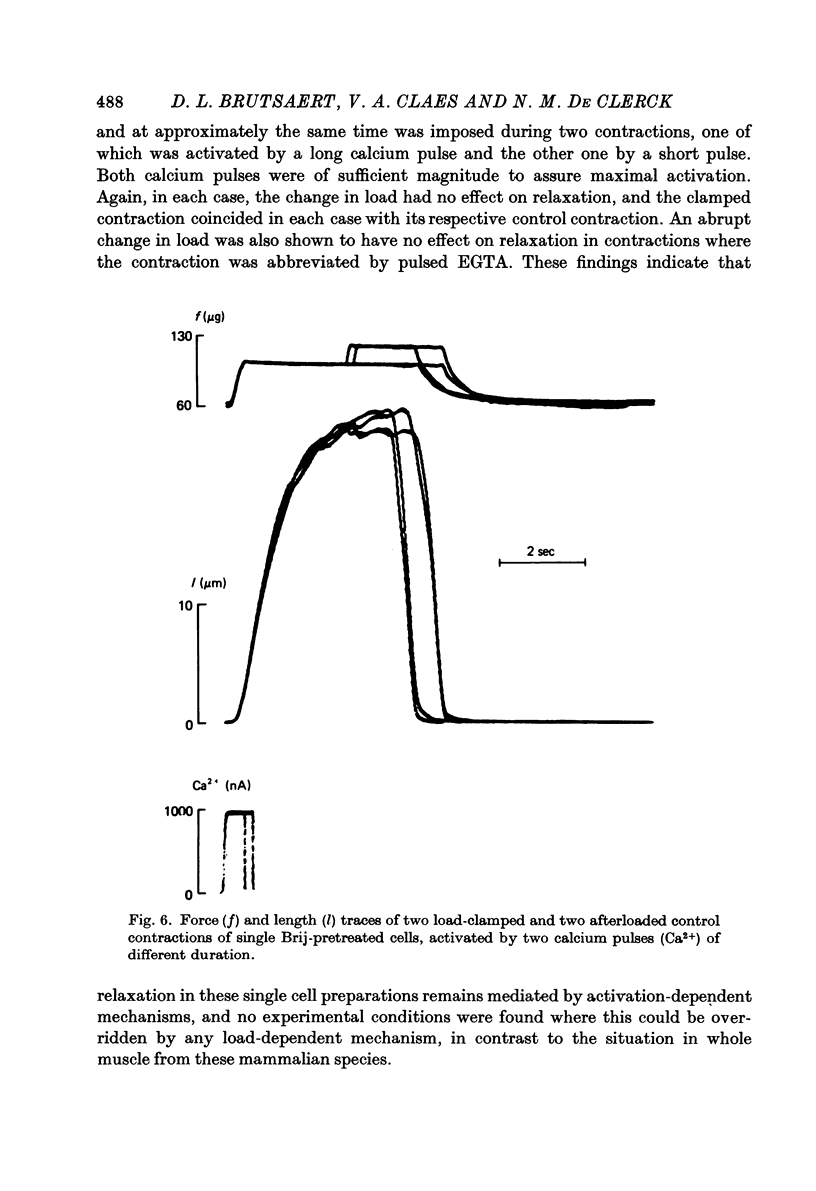Abstract
1. The influence of load and activation on relaxation of heart muscle has been studied. 2. Cardiac cells devoid of functioning sarcolemma were isolated from rat and cat ventricular myocardium. Pretreatment with the detergent Brij-58 destroyed residual sarcoplasmic reticulum function. In order to analyse the mechanical properties of relaxation in these cells, a new miniature transducer was designed which could measure force by feedback sensing (resolution of 1 microgram). Contraction was induced by ionophoretically released calcium ions. Activation, sequestration of calcium and loading conditions could be controlled independently. 3. The time course of relaxation was shown to be governed by the amount of calcium released, and unlike intact preparations from rat or cat heart (but like those from frog), to be independent of load and of alterations in load. 4. We conclude that relaxation of the cardiac contractile system is determined basically by an activation-dependent mechanism, which is masked by load dependence in intact muscle preparations with a well developed calcium sequestering membraneous system.
Full text
PDF










Selected References
These references are in PubMed. This may not be the complete list of references from this article.
- Briggs F. N., Poland J. L., Solaro R. J. Relative capabilities of sarcoplasmic reticulum in fast and slow mammalian skeletal muscles. J Physiol. 1977 Apr;266(3):587–594. doi: 10.1113/jphysiol.1977.sp011783. [DOI] [PMC free article] [PubMed] [Google Scholar]
- Brutsaert D. L., Claes V. A., Sonnenblick E. H. Effects of abrupt load alterations on force-velocity-length and time relations during isotonic contractions of heart muscle: load clamping. J Physiol. 1971 Jul;216(2):319–330. doi: 10.1113/jphysiol.1971.sp009527. [DOI] [PMC free article] [PubMed] [Google Scholar]
- Brutsaert D. L., de Clerck N. M., Goethals M. A., Housmans P. R. Relaxation of ventricular cardiac muscle. J Physiol. 1978 Oct;283:469–480. doi: 10.1113/jphysiol.1978.sp012513. [DOI] [PMC free article] [PubMed] [Google Scholar]
- De Clerck N. M., Claes V. A., Brutsaert D. L. Force velocity relations of single cardiac muscle cells: calcium dependency. J Gen Physiol. 1977 Feb;69(2):221–241. doi: 10.1085/jgp.69.2.221. [DOI] [PMC free article] [PubMed] [Google Scholar]
- Ebashi S., Endo M. Calcium ion and muscle contraction. Prog Biophys Mol Biol. 1968;18:123–183. doi: 10.1016/0079-6107(68)90023-0. [DOI] [PubMed] [Google Scholar]
- Endo M. Calcium release from the sarcoplasmic reticulum. Physiol Rev. 1977 Jan;57(1):71–108. doi: 10.1152/physrev.1977.57.1.71. [DOI] [PubMed] [Google Scholar]
- Fabiato A., Fabiato F. Calcium release from the sarcoplasmic reticulum. Circ Res. 1977 Feb;40(2):119–129. doi: 10.1161/01.res.40.2.119. [DOI] [PubMed] [Google Scholar]
- Fabiato A., Fabiato F. Contractions induced by a calcium-triggered release of calcium from the sarcoplasmic reticulum of single skinned cardiac cells. J Physiol. 1975 Aug;249(3):469–495. doi: 10.1113/jphysiol.1975.sp011026. [DOI] [PMC free article] [PubMed] [Google Scholar]
- Fawcett D. W., McNutt N. S. The ultrastructure of the cat myocardium. I. Ventricular papillary muscle. J Cell Biol. 1969 Jul;42(1):1–45. doi: 10.1083/jcb.42.1.1. [DOI] [PMC free article] [PubMed] [Google Scholar]
- Forssmann W. G., Girardier L. A study of the T system in rat heart. J Cell Biol. 1970 Jan;44(1):1–19. doi: 10.1083/jcb.44.1.1. [DOI] [PMC free article] [PubMed] [Google Scholar]
- Fozzard H. A. Excitation-contraction coupling and digitalis. Circulation. 1973 Jan;47(1):5–7. doi: 10.1161/01.cir.47.1.5. [DOI] [PubMed] [Google Scholar]
- Katz A. M. Contractile proteins of the heart. Physiol Rev. 1970 Jan;50(1):63–158. doi: 10.1152/physrev.1970.50.1.63. [DOI] [PubMed] [Google Scholar]
- Orentlicher M., Reuben J. P., Grundfest H., Brandt P. W. Calcium binding and tension development in detergent-treated muscle fibers. J Gen Physiol. 1974 Feb;63(2):168–186. doi: 10.1085/jgp.63.2.168. [DOI] [PMC free article] [PubMed] [Google Scholar]
- Vassort G. Influence of sodium ions on the regulation of frog myocardial contractility. Pflugers Arch. 1973 Mar 30;339(3):224–240. doi: 10.1007/BF00587374. [DOI] [PubMed] [Google Scholar]
- Winegrad S. Intracellular calcium binding and release in frog heart. J Gen Physiol. 1973 Dec;62(6):693–706. doi: 10.1085/jgp.62.6.693. [DOI] [PMC free article] [PubMed] [Google Scholar]


